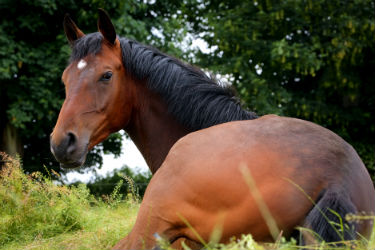Reducing Equine Exposure to Parasites

Internal parasites present a common and serious health concern to horses. While deworming strategies offer the most effective method for worm control, implementing farm management procedures will help to further reduce the parasitic worm population.
Why It is Important to Control Gastrointestinal Parasites
Internal parasites can cause permanent harm to any horse, regardless of age. During their life cycle, as they pass through the host, parasitic worms cause physical damage and create health problems, such as:
- Anemia
- Diarrhea
- Weight loss
- Loss of body condition
- Permanent damage to the lining of the bowel
- Nutritional deficiencies
- Stunted growth and development.
Types of Harmful Equine Gastrointestinal Parasites: Important Information to Know
Large Strongyles and Small Strongyles
- Of all of the gastrointestinal parasites, strongyles cause the most damage to the horse, with large strongyles being the most harmful
- Strongyles are transmitted almost exclusively on pasture when horses consume larvae during grazing
- With a life cycle that takes 11 months, the parasites within the horse are in various stages of growth at all times
- Eggs do not appear in the feces for up to 12 months after the point of initial infestation
- Once in the arteries, small strongyles are difficult to kill, making the elimination of the parasite before it reaches the migratory stage very important
- Small strongyles have a developed resistance to certain wormers
Ascarids
- Infect nursing and weanling foals, but rarely occurs in animals over 2 years of age
- Eggs are shed in feces, then taken up by the foal through contaminated feed or water
- Major adverse effects include malnutrition and stunted growth as foals fail to thrive
Threadworms
- First intestinal parasite to mature in foals
- Infection acquired through dam’s milk and through ingesting shed larvae in the mare’s feces
- In older horses, larvae infect the animal by burrowing through skin
- Creates damage to the animal’s skin, lungs, intestines
- Larvae of threadworms can also infect humans
Farm Management Procedures for Environmental Control of Internal Parasites
- Manure
- Remove manure and soiled stall bedding daily
- Clean manure from pastures and corrals at regular weekly intervals
- Dispose of manure properly
- Composted manure should age for one year before being spread as fertilizer on pastures
- Feed contamination
- Do not place grain or hay directly on the ground
- Prevent manure from contaminating water source
- Pastures
- Avoid overgrazing by rotating animals from one pasture to the next
- Avoid overpopulating pastures by maintaining one horse per 1 to 2 acres
- Pastures that have been grazed thoroughly should be kept free of animals for 4 to 12 months
- Keep the following information in mind:
- There is no such thing as a “killing frost” when it comes to most parasites
- Larva can survive under snow, in cold and freezing temperatures
- Larvae die quickly when the temperatures goes over 90 degrees Fahrenheit
- The peak times for parasite transmission occur in spring and fall
- Quarantine
- New animals should be quarantined for a minimum of 48 hours, but ideally for at least 2 to 3 weeks
- During their quarantine, owners should obtain a fecal sample for testing and initiate a deworming regimen
- Deworming
- Working with the veterinarian, establish a plan that monitors the effectiveness of the deworming program, obtains fecal egg count samples, and applies dewormer
- On farms with a large number of horses, collecting from 20% of the population will provide a representative sample
Reducing an animal’s exposure to worm larvae and eggs can become more effective when control is established over the animal’s environment.
Contact Covetrus online or at 855.724.3461 for additional information on preventing parasitic infestations!
Sources:Horse Owner’s Veterinary Handbook, 3rd ed., by T. Gore, P. Gore, J.M. Giffin
The Merck Veterinary Manual, 8th ed., Merck & Co., Inc. Whitehouse Station, NJ, U.S.A.
Need Regulatory Assistance
If you need help with regulatory or licensing issues, we're happy to help. We have a wide variety of resources to help you when issues arise.

Careers
Are you looking for a place to let your talents shine? At Covetrus, we help our practitioner customers better serve their patients and take pride in providing the best customer experience possible. Search our open positions to see our available opportunities.
Newsletter
Stay current with what’s going on with Covetrus, subscribe to receive our newsletter and email communications. Subscribers will receive the latest information in practice management, sales and marketing, animal health, and more.


Leave a comment